From Szolnok to Cold Lake, via the Moose’s Jaw
Szöveg: László Szűcs | 2008. április 14. 6:00The Canadian aircraft pilot training programme of the Hungarian Defence Forces is the most successful project among those aimed at educating a new generation of well-trained experts for the HDF. Within the framework of the NFTC (NATO Flying Training in Canada) Programme, each year eight students have a chance to go to Canada to learn the basics of military aviation. The training consists of four phases, with the first phase in Hungary, where students fly Jak–52 training aircrafts at the Szolnok Helicopter Base. Honvedelem.hu visited the site to inquire about the details of the programme.
The first Jak–52 aircraft appearing above the treetops is approaching the airstrip a bit wobbling, the pilot corrects several times to the lateral directions before landing the aircraft. Compared to the first flyer, the pilot of the next propelled training aircraft has a sure grip, he lands almost perfectly – despite the fact that both pilots had flown only 6 hours with this type of plane.
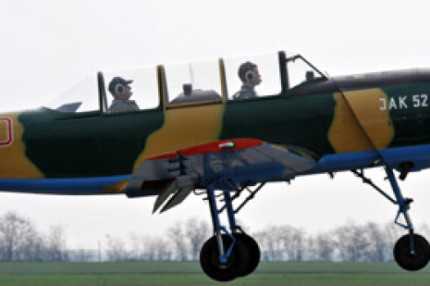
From Recruitment to Liaisoning
"Whenever it is possible, or I should say whenever the weather conditions allow, we have planned two takeoffs per day for the students" – says Lieutenant-Colonel István Nagy, Head of the Aircraft Preparation Department (RFO). This time the word ’student’ sounds a bit odd, since we are talking about officers in lieutenant rank, but this is how youngsters participating in the NFTC Programme are traditionally called in Szolnok.

The Hungarian Defence Forces have entered a contract in 2002 with the Canadian party for the implentation of the NATO Flying Training in Canada Programme for a term of 17 years. The national management of the Programme was assigned to the RFO, an unit working under the command of the Joint Forces Command of the HDF. "Management means that the Department participates in the work as early as the studens are recruited, and the RFO staff is in charge of the Hungarian training stage, as well as the students’ leave for Canada. Moreover, they contact pilot candidates in training in the North-American country nearly every day" – says Lt. Colonel Nagy.
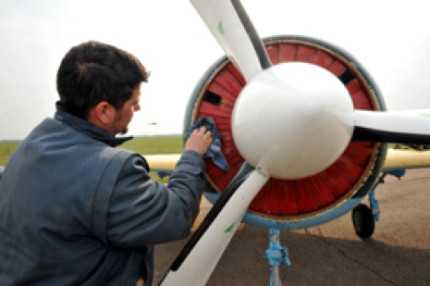
"The first group, consisting of 8 students, went to Canada in 2004" – tells us the Head of RFO. Later he adds: " … there were only 5 of them who had actually graduated, but this dropout level is standard, even if each candidate has to complete several tests before even getting admittance to the programme. After all, the job of a fighter pilot is one of the most difficult tasks in the world…"
Even the Eligible May Fail
To my question on how one can get admittance to the programme the Lt. Colonel replies "It’s simple. Anyone interested in aviation, more precisely in fighter pilot training, can send their application form to the RFO, if they have an university or college degree and a minimum intermediate proficiency in English."
The previous years’ experience has shown that usually there are 200 applicants. However, following a very restrictive flight physical examination conducted by flight surgeons, normally only one in ten applicants qualifies eligible. But even among candidates who are medically fit, there will be some who can fly subsonic aircrafts or rotorcrafts only – that is medical category 1/B. The fighter plane training is for 1/A category candidates only.
Major Tamás Bali, Training Staff Officer at RFO tells me that experience has proven that a certain ratio of medically eligible candidates ’bleed out’ on the physical tests, furthermore there usually are some applicants who have difficulties with the English language thus have to be rejected. Thus 10–12 candidates are given admittance to the programme each year.
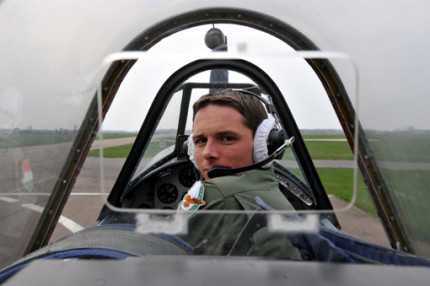
The NFTC Programme is scheduled for 3 years, the first year being hosted in Hungary. Preparations commence in August and the first 6 months is the time of basic military training, followed by a paratrooper training, and a course on the theory of aviation.
"Prior to the practical training – a part of the Hungarian phase – the group, consisting of officers in a lieutenant rank by that time, is divided in two parts on the basis of their English proficiency. The so-called advanced group will fly an aircraft as early as March, the intermediate group will have to enroll another English course and take 160 lessons, then start flying in May, when the advanced group will have completed their obligatory 45 hours on the Jaks" – says Lt. Colonel Nagy.
The key objective in flying Jak–52s is preselection. Candidates are tested whether they are eligible for flying other aircraft types, since if there is anybody who is not eligible, he will have to terminate the programme, and he will be offered a ground position.
"A healthy competition has evolved among group members, knowing that only the best can get to Canada. It is for the better if everybody is clear on the fact that even if he was admitted to the programme, it doesn’t automatically mean that he will be a pilot indeed" – adds Major Bali.

We move on to the technicalities, discussing for instance that the 45 hours spent airborne with Jaks is just enough for learning about basic aviation techniques and navigation, and get a taste of basic aerobatics. The latter is necessary in order to test the students for overload, to identify who is eligible for becoming a pilot.
The Moose’s Jaw
The Canadian stage of the NFTC Programme lasts at least 22 months, but due to the weather conditions and other factors students often spend more than 2 years overseas. Fortunately, the legislation in effect allows those with a family or living in common-law marriage to take their family members with them in case they are assigned to work abroad for more than 1 year. The training contract disposes of a free flight home every 6 months for the officers participating in the programme.
The students complete three programme phases in Canada, the first starting immediately with a 12-week intensive language course at the University of Regina. In the scope of the language training tutors pay special attention to aviation terminology and the rules of radio operation. The course ends with an exam and only those who pass can move on to the military training base near Moose Jaw.
"The students fly Harvard type propeller-driven training airplanes on this base" – says Lt. Colonel Nagy, and moves on to the technical parameters of the aircraft. Its performance is nearly twice that of the Hungarian Jak–52s; it is operated by a turbo propeller, and has a digital display, and catapults, as well. There is 90 hours total flight time available for mastering the basic aviation techniques, visual and instrumental procedures, navigation tasks, and route flights in the training schedule for phase 2/A.
In phase 2/B students have 51 hours to practice complicated aerobatic drills, flying in formation, and flying close to the ground.
Aerobatics and Attacking Ground Targets
The third phase of the NFTC Programme is still hosted by the Moose Jaw Base, but this time students move up to Hawk jets. These training aircrafts have two seats, and a fully digitalised system, and are capable of reaching sonic speed. Lt. Colonel István Nagy tells us that the students have 72 hours to fly on these jets and practice the basic aviation techniques, navigation and route flying, simple/complicated aerobatics figures. In case the students pass this phase with success, they become pilots, in line with the official NATO terminology, and are given the wings for their flying uniform.
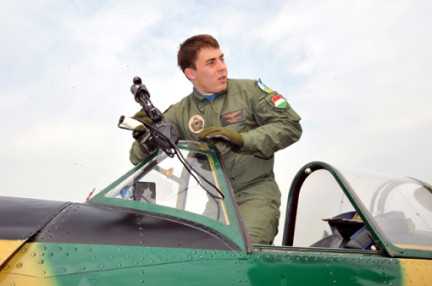
The fourth and last phase of the Canadian training programme takes place at Cold Lake Air Force Base. The training is still on Hawks, but the candidates will practice the core defence and attack manoeuvres, the use of on-board weapons, and the attack of ground targets, as well, for which they are given 52 hours.
"Some basic arithmetic operations, and we have the product: each student flies 310 hours while in the programme, which is enough for mastering the basic aviation tasks, but no-one can be automatically called a fighter pilot – yet" – reckons Lt. Colonel István Nagy, and adds that the special fighter pilot training takes place in Hungary again, at the Kecskemét Air Base.
Cargo Aircrafts and Helicopters
When inquiring about the further training of officers dropping out of the NFTC Programme I learn that these students are offered positions on the cargo aircrafts or helicopters of the HDF. At the moment this training is given by different corps, but there is an RFO plan for launching a training programme on flying helicopters. Major Bali, the leader of the project says they plan to train officers – who were either given a 1/B medical category or returned early from their training in Canada, so far 4 students in 4 years – on hired light helicopters.
Since 2002, 15 men have completed the NFTC Programme. According to the plans this year 6, and in 2009 5 persons will comply with the requirements. In the first training phase there were 11 students who finished their training early in Hungary, and there were 4 who had to exit the programme in Canada. Another point of relevance: among graduates, 3 men have returned to Canada as trainers, meaning that today they train the future fighter pilots of the 11 countries participating in the NFTC Programme.
The Four Students
While we were discussing the details of the programme, the students have returned from their second flight. There are four lieutenants who commenced their practical training in early March. At the moment they have completed 7–8 tasks, and have spent 6 hours in air with Jak–52 training aircrafts regularly used by the HDF.
Lieutenant József Papp has flown gliders since secondary school and spent more than 1.000 hours airborne. He says he is simply in love with flying, that is why he applied to the NFTC Programme. He was qualified 1/A in the flight phyisical examination in 2003, but had to commence his college studies, therefore he enrolled in the training programme only last year. Among his tasks, the first instrumental flying exercise made 27-year-old mechanical engineer sweat the most, since it was unusual for him that he had to keep his eyes on the displays. He enjoys flying very much, although on the paratrooper exercise he almost gave up his dreams: he put large efforts in convincing himself to jump out of the helicopter…
Lieutenant Ákos Orosz felt the same about the paratrooper exercise – the 24-year-old man is a graduate of Veszprém University, Faculty of English. He applied to the programme following graduation and has a 40-hour experience in the air, which he, too, gained on a glider. He is smiling when he is telling me about how strange he felt when he had to fly an aircraft that has a propeller, and how he had to pay attention to a multitude of things, compared to a glider. On the day of the report he completed two takeoffs and had to execute various tasks in the designated airspace nearby the military airfield of Szolnok. He practiced the 60° turn, getting out of a screwdriver, and fall-jumps.
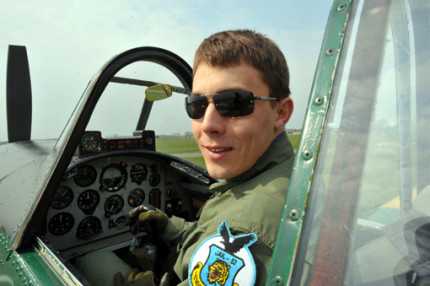
Unlike his ’schoolmates’, Lieutenant Balázs Csongrádi enjoyed the paratrooping exercise. The 24-year-old officer loves extreme sports, therefore jumping with a parachute wasn’t a problem for him – he would have been glad to jump more times, than the required 12. Being a graduate in IT, he has no previous aviation experience, or as he puts it he was a ’0 mile’ participant when he commenced the practical part of the programme. Nevertheless, he makes every effort to correct his ’handicap’, and his fellow men support him in this as well.
Lieutenant Máté Csonka is the only enlisted member of the quartet. He graduated from ’Zrínyi Miklós’ University of National Defence, while the other three students have attended civilian higher education institutions, therefore enrolled in the training as contracted officers. For the 23-year-old officer it is a childhood dream to become a fighter pilot, but in the year he had to choose a profession, the Aviation Officers Training College in Szolnok did not offer a course for pilots. Lt. Csonka enrolled the Air Raid Rocket Department of ZMNE, where he learned about the NFTC Programme and he applied immediately after taking his officers’ oath. He hopes his dream – flying over Hungary in a Gripen fighter in 3 years’ time – will come true.